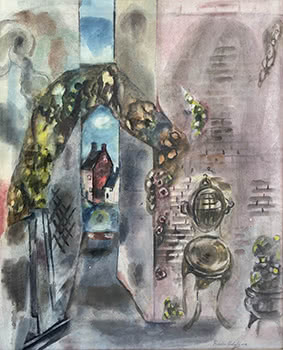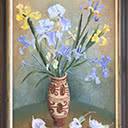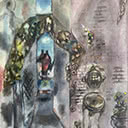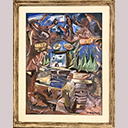Side Entrance
54 x 43 cm
est. $80,000 - 120,000
PROVENANCE
Collection of the late Dr Richard (Dick) Bomford, UK
Purchased from Alex Reid & Lefevre
(The Lefevre Galleries),
Original Lefevre Galleries label affixed verso
EXHIBITED
New Paintings and Watercolours,
Alex Reid & Lefevre, (The Lefevre Galleries), 1937
The Complete Frances Hodgkins
catalogue raisonn no. FH1316
Although the exhibition at the Lefevre Galleries, London, in which Frances Hodgkins' Side Entrance was included in 1937 was titled New Paintings and Watercolours, this was something of a misnomer. Just before the show opened on 27 October, she wrote to her good friend Dorothy Selby; 'I am not very excited. I have been bustled into getting ready & have had a lot of work to do, but you won't see any brand new work I think & I myself don't know what is being shown. We all hope it may be a success in spite of the political crises & menacing outlook abroad. . .' (https://completefranceshodgkins.com/ objects/29997/letter-from-frances-hodgkins-todorothy- selby) Despite her original protestations, Hodgkins did attend the exhibition opening, and the show proved a great success. Included in the show were several paintings and watercolours created when staying in Bridgnorth, one of her favourite English villages, including Side Entrance. Hodgkins first introduced elaborately decorated plant pots, garden urns, and other garden ornaments into a series of watercolours done in Flatford Mill, Suffolk in the summer and early autumn of 1930, often setting them beside the riverbank with flowing water beyond. Side Entrance, however, belongs to a slightly later period. Hodgkins returned to similar motifs in 1932 when she was staying in Bridgnorth, but her treatment of these objects had changed over the preceding two years. Her forms were defined more loosely, suggesting a random juxtaposition within each work. These compositions reward close examination. The central narrow passage in Side Entrance opens out onto the riverbank, the building on the left drawn as if it reaches right to the bank, whereas that on the right suggests an open space beyond it. Our eye is drawn to the blue beyond, enhanced by a yellow circle that blends into a greenish haze, not dissimilar to a circular crochet mat, while the two houses opposite seem to float in the water itself. In the foreground on the right a delicate, ornamental chair, its seat tipped upright defying any sort of perspective, appears to have a transparent back made of the brickwork against which it rests. To the right, a decorative urn supports a dense clump of bright yellow flowers. Hodgkins was particularly fond of this acidic colour, which found its way into many of her paintings. Flower-draped arbours also appealed, their arched shapes anchoring combinations of abstracted leaves and flowers, framing the view of the river or landscape beyond. It is possible that the arbour included in 1926 (https://completefranceshodgkins. com/objects/26452/r i ver-severn)appears again in Enchanted Garden 1932, https:// completefranceshodgkins.com/objects/26393/ enchanted-garden) where its form is distorted horizontally to provide a broader view of the river and its pleasure boats. In Side Entrance she stretches the arbour vertically to emphasise the narrow gap between the two buildings and soften their angularity. The pink of the roses entwining the arbour migrates as a rosy blush of watercolour on the brick wall to the right. The black crosshatching to the left also appears in other Bridgnorth watercolours, and the urn of flowers and spindly garden chair are also reminiscent but not imitative of similar elements as well. There is a delicious, dreamy aspect to Side Entrance, suggesting that it might have been worked up in her studio from earlier sketches, weaving objects from memory to create a scene that gave her pleasure. Her friend and supporter Geoffrey Gorer also delighted in this kind of composition. Reviewing the Lefevre exhibition, he noted; From her world human beings are almost excluded, but not their products. . . In nearly all Frances Hodgkins' pictures there is the open air, the landscape, objects either natural or manufactured… which contrast or harmonise with and accent the landscape in which they are placed… With her colour magnificent and free Frances Hodgkins surveys the world of nature and objects, and by the colour transforms it so that it renders an emotion intensely felt and vividly communicated - an emotion sometimes grave and dramatic, but more often gay with the slightly inhuman and profound gaiety of an innocent demiurge who looks on the world he has created and sees that it is good. Geoffrey Gorer, The Art of Frances Hodgkins', Listener 17 November 1937, pp108 2-3. Reproduced in Art New Zealand, March 1938, pp 160 -3.
MARY KISLER





